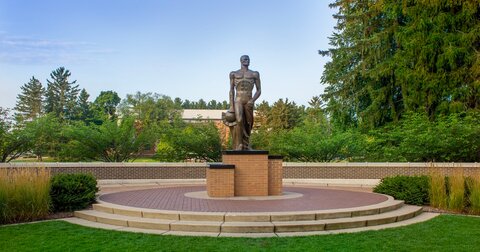Commentary
Lack of Money For Universities Didn’t Cost Michigan Amazon – Or Economic Growth
There is little relationship between state spending and results

PxHere
The lobbyist for Michigan’s 15 public universities says taxpayers are to blame for tuition hikes, an insufficient number of poor kids attending college, a lack of a talented workforce and the state missing out on the Amazon headquarters. But there’s little evidence for this.
Daniel Hurley, CEO of the Michigan Association of State Universities, notes that Michigan is now 44th in the nation among the states when it comes to per capita spending on universities.
“As lawmakers move toward completion on the state’s budget, they should remember that college graduates are the vital ingredient in a successful knowledge economy – one with high-paying jobs,” he writes. “We are winning Amazon warehouses, with $15-an-hour jobs. We didn’t even get a serious consideration for Amazon’s HQ2 jobs, paying $100,000 a year.”
It’s true that Michigan has dropped in the rankings of state spending on universities. The state cut spending on universities during the “Lost Decade” of the 2000s and has increased taxpayer support since 2012.
But there is little evidence this spending affected state economic growth and Amazon’s decision.
Simply put, there is no correlation between state higher education spending and college degrees – much less economic growth and a “talented workforce.” In fact, states that spend less per person on higher education have a higher percentage of college graduates. New Hampshire spends the least in the nation on higher education. It isn’t close, with the state spending less than half of what Michigan does on a per capita basis. But the Granite State is in the top 10 for the number of college graduates, in both undergraduate and advanced degrees.
In fact, of the 10 states with the highest percentage of college graduates, none are among the leaders in university spending. Massachusetts leads the nation in the percentage of its population with a college degree, but it ranks only 36th for university spending. Other states, ranked in descending order by the percentage of their population with a degree and matched to their rank for university spending, are as follows: Colorado (45th), Maryland (11th), Connecticut (15th), New Jersey (34th), Virginia (32nd), Vermont (47th), New Hampshire (50th), New York (16th) and Minnesota (18th).
Amazon ultimately decided to make its major investments in Virginia and Tennessee. Per capita spending in those states on universities is 32nd and 20th in the nation. State spending on state universities is unlikely to have been a factor.
Michigan lawmakers should certainly evaluate the taxpayer dollars they send to universities. Right now, the state appropriates money to its 15 public universities, but pays minimal attention to how these funds are used. So the case for greater taxpayer support is overblown.
|

Lack of Money For Universities Didn’t Cost Michigan Amazon – Or Economic Growth
There is little relationship between state spending and results
The lobbyist for Michigan’s 15 public universities says taxpayers are to blame for tuition hikes, an insufficient number of poor kids attending college, a lack of a talented workforce and the state missing out on the Amazon headquarters. But there’s little evidence for this.
Daniel Hurley, CEO of the Michigan Association of State Universities, notes that Michigan is now 44th in the nation among the states when it comes to per capita spending on universities.
“As lawmakers move toward completion on the state’s budget, they should remember that college graduates are the vital ingredient in a successful knowledge economy – one with high-paying jobs,” he writes. “We are winning Amazon warehouses, with $15-an-hour jobs. We didn’t even get a serious consideration for Amazon’s HQ2 jobs, paying $100,000 a year.”
It’s true that Michigan has dropped in the rankings of state spending on universities. The state cut spending on universities during the “Lost Decade” of the 2000s and has increased taxpayer support since 2012.
But there is little evidence this spending affected state economic growth and Amazon’s decision.
Simply put, there is no correlation between state higher education spending and college degrees – much less economic growth and a “talented workforce.” In fact, states that spend less per person on higher education have a higher percentage of college graduates. New Hampshire spends the least in the nation on higher education. It isn’t close, with the state spending less than half of what Michigan does on a per capita basis. But the Granite State is in the top 10 for the number of college graduates, in both undergraduate and advanced degrees.
In fact, of the 10 states with the highest percentage of college graduates, none are among the leaders in university spending. Massachusetts leads the nation in the percentage of its population with a college degree, but it ranks only 36th for university spending. Other states, ranked in descending order by the percentage of their population with a degree and matched to their rank for university spending, are as follows: Colorado (45th), Maryland (11th), Connecticut (15th), New Jersey (34th), Virginia (32nd), Vermont (47th), New Hampshire (50th), New York (16th) and Minnesota (18th).
Amazon ultimately decided to make its major investments in Virginia and Tennessee. Per capita spending in those states on universities is 32nd and 20th in the nation. State spending on state universities is unlikely to have been a factor.
Michigan lawmakers should certainly evaluate the taxpayer dollars they send to universities. Right now, the state appropriates money to its 15 public universities, but pays minimal attention to how these funds are used. So the case for greater taxpayer support is overblown.
Michigan Capitol Confidential is the news source produced by the Mackinac Center for Public Policy. Michigan Capitol Confidential reports with a free-market news perspective.
More From CapCon